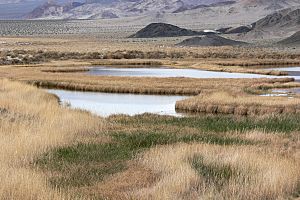Saratoga Springs pupfish facts for kids
Quick facts for kids Saratoga Springs pupfish |
|
|---|---|
| Scientific classification |
|
| Kingdom: | Animalia |
| Phylum: | Chordata |
| Class: | Actinopterygii |
| Order: | Cyprinodontiformes |
| Family: | Cyprinodontidae |
| Genus: | Cyprinodon |
| Species: | |
| Subspecies: |
C. n. nevadensis
|
| Trinomial name | |
| Cyprinodon nevadensis nevadensis (C. H. Eigenmann & R. S. Eigenmann, 1889)
|
|
The Saratoga Springs pupfish (Cyprinodon nevadensis nevadensis) is a special type of fish. It is a subspecies of the Amargosa pupfish (Cyprinodon nevadensis). This tiny fish belongs to the pupfish family.
It lives only in one place in the world. This place is Saratoga Springs. Saratoga Springs is a small wetland. It is found inside Death Valley National Park in the United States.
Contents
What is a Pupfish?
The pupfish is part of a group of fish called Cyprinodon. Many different Cyprinodon species developed a long time ago. This happened during the Ice Age. At that time, large lakes sometimes filled the desert area.
When these lakes dried up, small groups of pupfish became separated. This led to new species forming. One of these new species was C. nevadensis.
How the Pupfish Got Its Name
Two fish scientists, Rosa Smith Eigenmann and Carl H. Eigenmann, first identified Cyprinodon nevadensis. They did this in 1889. Later, other scientists thought it was the same as another fish.
But in the 1940s, scientist Robert Rush Miller said C. nevadensis was its own species. He also found six different types, or subspecies. The Saratoga Springs pupfish (C. n. nevadensis) is one of these types.
Other Pupfish Relatives
There are other subspecies of the Amargosa pupfish. They include:
- the Amargosa River pupfish (C. n. amargosae)
- the Ash Meadows pupfish (C. n. mionectes)
- the Warm Springs pupfish (C. n. pectoralis)
- the Shoshone pupfish (C. n. shoshone)
- the Tecopa pupfish (C. n. calidae), which is now extinct.
What Does It Look Like?
Male Saratoga Springs pupfish are a bright blue color. Female pupfish are a dull olive-brown color. These fish are quite small. They are usually about 4 centimeters (1.6 inches) long. Their total length is rarely more than 5 centimeters (2 inches).
What Do They Eat?
The Saratoga Springs pupfish eats what most pupfish eat. Their main food is Cyanobacteria, also known as blue-green algae. They have long guts that help them digest this food.
They also eat small creatures like Ostracods and copepods. They also eat the larvae of tiny flies called chironomids. These foods are available at different times of the year.
How Do They Reproduce?
The way these pupfish mate is special. It is different from pupfish that live in streams. But it is similar to other pupfish that live in springs.
Male pupfish guard their own areas. Females lay their eggs in these areas all year long. These fish can live in many different temperatures. However, they only lay eggs when the water is between 24 and 30 degrees Celsius (75 and 86 degrees Fahrenheit).
Where Do They Live?
The Saratoga Springs pupfish naturally lives only at Saratoga Springs. This place has a spring pool that is about 9 meters (30 feet) wide. It is also 1 to 2 meters (3 to 6 feet) deep.
Water from this spring flows into several ponds. These ponds cover about 1.6 to 2.4 hectares (4 to 6 acres). The spring water stays at a steady 28 to 29 degrees Celsius (82 to 84 degrees Fahrenheit). But the ponds change with the seasons. They can range from 10 to 49 degrees Celsius (50 to 120 degrees Fahrenheit).
Young fish are found in the ponds. But very young fish are not usually found in the spring itself.
Other Locations
Some Saratoga Springs pupfish were moved to Lake Tuendae. This is a man-made pond in Zzyzx, California. But it is not clear if they still live there today.
Protecting the Pupfish
The Saratoga Springs pupfish does not have an official protection status. However, the state of California thinks it might need to be protected. This is because it lives in such a small area.
There is also a worry that pumping water from far away could harm the spring. This water comes from an underground water source called an aquifer. This aquifer might reach as far as western Utah. Pumping water in the Las Vegas Valley, which is about 120 kilometers (75 miles) away, is a big concern.
To help protect the pupfish and other sensitive animals, the National Park Service has rules. Visitors are not allowed to enter the wetland area at Saratoga Springs.


